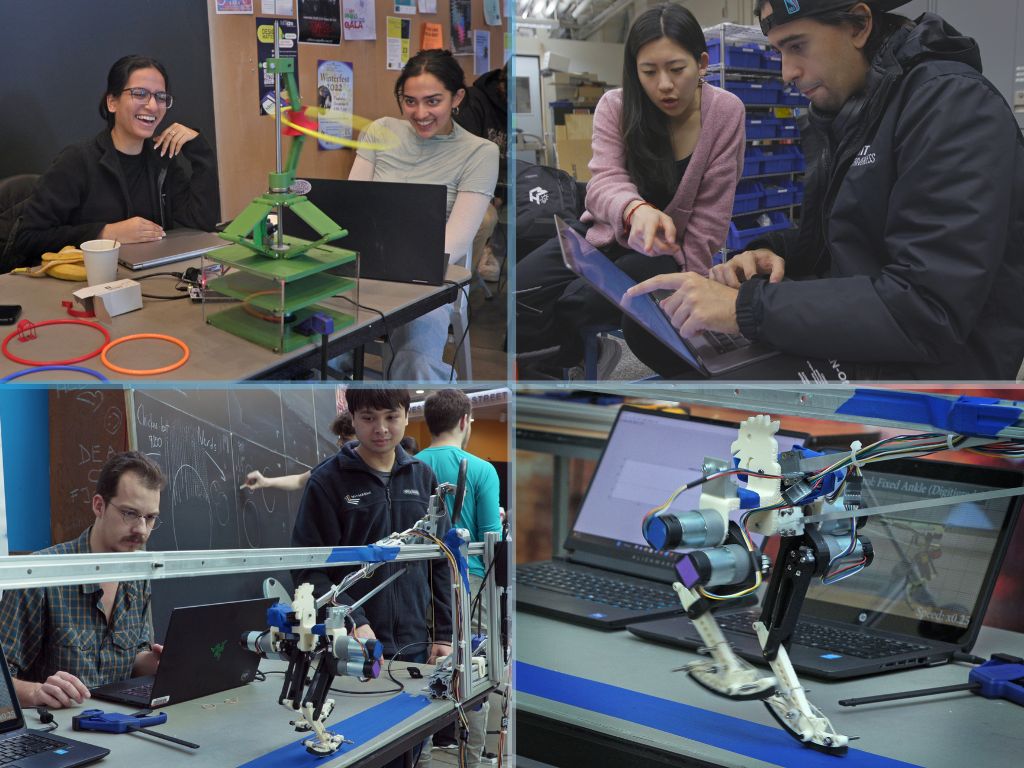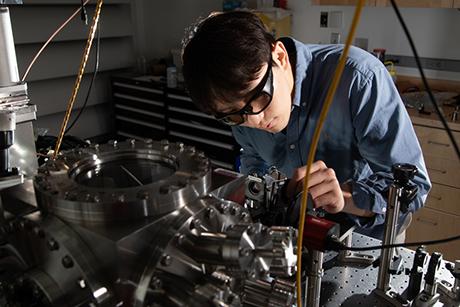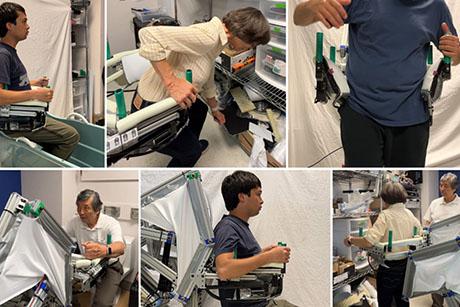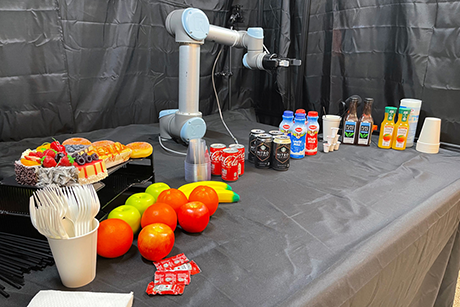Bioinspired robotics class offers intriguing surprises
When MIT’s mini cheetah perfectly executed a backflip on “The Tonight Show Starring Jimmy Fallon,” the audience screamed and applauded wildly. If this machine — which also pranced around the stage like a show dog and stretched in several different directions — could perform such a difficult maneuver, one that is impossible for most humans, it should be easy to get it to perform all kinds of everyday tasks.
“Achieving robot tasks that are seemingly easy for us is often extremely difficult and complicated,” says Kim. “We tend to think of a task’s difficulty based on human standards.”
Enter Kim’s class, 2.74 (Bio-Inspired Robotics).
According to Kim, researchers need to understand this cognitive bias, this tendency toward anthropomorphism, in order to even begin developing robots that can help humans with their physical movements. While Kim’s research interest is in building robots that could help people, such as the elderly in an aging population with fewer young people to perform services, such advancement is not even possible without understanding biology, biomechanics, and how much we don’t understand about our own everyday movements.
"One big thing students should learn in this class is not necessarily to understand how we move our body but the fact that we don’t understand how we move,” Kim says. “One of our ultimate goals in robotics is to develop robots that help elderly people by mimicking how we use our arms and legs, but if you don’t realize how little we know about how we move, we cannot even start tackling this problem.”
The first half of the class, which is made up of 50 or fewer seniors and graduate students, is devoted to biology and biomechanics. Confronted with how little we know about the subconscious processes that allow humans to interact with their environment, students have a sense of wonder, Kim says.
“During the lecture, students look at their hands like a robotic system, how they move and how they work. Teaching about how we move and how to create similar behavior in robots, understanding both worlds, is intrinsically interesting,” Kim says. “They are like, ‘This is very different from what I thought it was. I didn’t know about this.’”
“This is the driving force of the entire class,” he adds. “This is how we’re thinking and having fun.”
Roberto Bolli, who is in the second year of a master’s program, says one of the most surprising things he learned in 2.74 has to do with how humans walk.
“Walking is essentially continuous falling, where the center of mass of the body falls forward like an inverted pendulum,” says Bolli, whose 2.74 team developed a robot named Chicken-Bot 9000. “This means that our maximum walking speed is roughly determined by the length of our legs and gravity, and not by our fitness or overall stamina.”
The research projects that 2.74 students embark on in the second half of the class single out very specific biological behaviors to study, seeking to employ the simplest model possible. For example, they might investigate where a battery or other payload should be located on a jumping robot in order to achieve the highest jump.
Through this process, students can compare what they have learned about biology to robotics as they develop and fine-tune hypotheses, the ideas for which come from biology but need to be reconstituted in a robotics context, Kim says.
“If you saw a kangaroo jumping, you might say, how can a kangaroo jump so high? I can’t test with the animal, and you really need to think three times about it. We don’t have the same kind of muscle in a robot, right? We don’t have the same kind of tendons. So, we have to reassemble the hypothesis in the robotics context,” Kim says. “Half the class is about biology and biomechanics so students can really compare muscles versus electric motors, computers versus our brain, computer algorithms versus our motor control.”
Bolli says the class helped him to learn a “systematic methodology for applying biological concepts to mechanical systems.”
“Biomimetics isn’t just ‘let’s copy this design we found in nature and see how well it works on a robot,’” he says. “It’s about extracting useful principles from natural systems to solve such challenges as manipulation and locomotion in novel and interesting ways.”
Jess Han, a first-year MS-PhD student, makes the point that she and her fellow student researchers “need to be cautious and think critically about what aspects of biology we try to emulate through our robots,” because nature does not always offer the best design.
“Natural selection allows for things that are ‘good enough’ to survive instead of selecting for the optimal solution,” says Han, who was involved in creating Suni-Bot, named after Olympian gymnast Suni Lee. “If we copy biology without thinking, we may actually design robots that aren’t as effective as they could be or that don’t fully utilize the capabilities of the technology that we have.”
The students study and experiment with both the robot hardware and a computer simulation. Kim says 70 percent of the class is programming; the data from the dynamic simulation and the hardware results are used to draw a scientific result.
Kim says such findings can enlighten small regions of the huge, unknown expanse of subconscious behaviors behind much of human movement.
“No matter how we study our human body, I don’t think we can figure out the big question of how we move,” he says. “Rather, you build a robotic system and then try A, B, C. And then if you find something applicable, you say, ‘Huh, that must be how we actually control [a particular movement].’”
Even the most advanced robotics researchers “don’t know what kind of robot is going to help people at this point,” Kim says. “We’re just building component technology.”
In the meantime, Kim’s Bio-Inspired Robotics class is providing fertile ground for experimentation.
“Students were definitely fond of their robots,” Bolli says. “We self-organized into small groups for the final project, so everyone was working on some aspect of biomimetics they were personally interested in. I saw some pretty ‘out-there’ projects, such as a hula-hooping robot and a leg jumping on a trampoline. As a mechanical engineering student, I think I was much more excited about the ‘manus’ aspect of ‘mens et manus’ [‘mind and hand,” MIT’s motto], so labs that involved building and controlling robot legs, as well as the final project, were definitely the most interesting part of the class.”
This article appeared in the Spring 2024 edition of our magazine, MechE Connects. For more stories, and for past issues, please visit meche.mit.edu/magazine.



